
Routt County is a county located in the U.S. state of Colorado. As of the 2020 census, the population was 24,829. The county seat is Steamboat Springs. Routt County comprises the Steamboat Springs, CO Micropolitan Statistical Area.
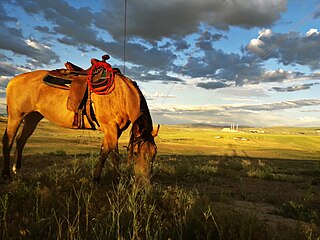
Moffat County is a county located in the U.S. state of Colorado. As of the 2020 census, the population was 13,292. The county seat is Craig. With an area of 4,751 square miles, it is the 2nd largest county by area in Colorado, behind Las Animas County.

The City of Steamboat Springs is a home rule municipality that is the county seat and the most populous municipality of Routt County, Colorado, United States. Steamboat Springs is the principal city of the Steamboat Springs, CO Micropolitan Statistical Area. According to 2019 census data, the city had an estimated population of 13,214.
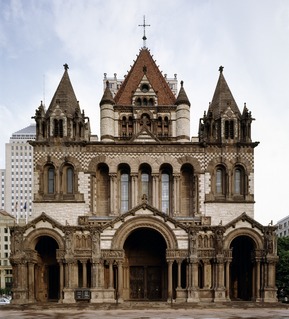
Richardsonian Romanesque is a style of Romanesque Revival architecture named after the architect Henry Hobson Richardson (1838–1886). The revival style incorporates 11th and 12th century southern French, Spanish, and Italian Romanesque characteristics. Richardson first used elements of the style in his Richardson Olmsted Complex in Buffalo, New York, designed in 1870. Multiple architects followed in this style in the late 1800s; Richardsonian Romanesque later influenced modern styles of architecture as well.
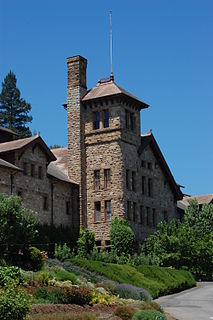
The Culinary Institute of America at Greystone is a branch campus of the private culinary college the Culinary Institute of America. The Greystone campus, located on State Route 29/128 in St. Helena, California, offers associate degrees and two certificate programs in culinary arts and baking and pastry arts. The CIA at Greystone and the Culinary Institute of America at Copia make up the school's California branch.
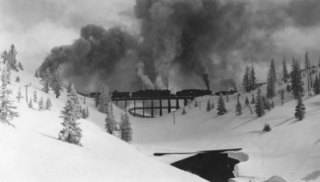
Rollins Pass, elevation 11,676 ft (3,559 m), is a mountain pass and active archaeological site in the Southern Rocky Mountains of north-central Colorado in the United States. The pass is located on and traverses the Continental Divide of the Americas at the crest of the Front Range southwest of Boulder and is located approximately five miles east and opposite the resort in Winter Park—in the general area between Winter Park and Rollinsville. Rollins Pass is at the boundaries of Boulder, Gilpin, and Grand counties. Over the past 10,000 years, the pass provided a route over the Continental Divide between the Atlantic Ocean watershed of South Boulder Creek with the Pacific Ocean watershed of the Fraser River, a tributary of the Colorado River.
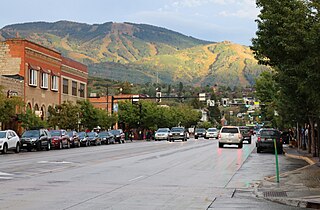
Mount Werner is a mountain summit in the Park Range of the Rocky Mountains of North America. The 10,570-foot (3,222 m) peak is located in Routt National Forest, 4.6 miles (7.4 km) east-southeast of the City of Steamboat Springs in Routt County, Colorado, United States. The mountain was renamed in 1964 in honor of skier Buddy Werner.

Carpenter Gothic, also sometimes called Carpenter's Gothic or Rural Gothic, is a North American architectural style-designation for an application of Gothic Revival architectural detailing and picturesque massing applied to wooden structures built by house-carpenters. The abundance of North American timber and the carpenter-built vernacular architectures based upon it made a picturesque improvisation upon Gothic a natural evolution. Carpenter Gothic improvises upon features that were carved in stone in authentic Gothic architecture, whether original or in more scholarly revival styles; however, in the absence of the restraining influence of genuine Gothic structures, the style was freed to improvise and emphasize charm and quaintness rather than fidelity to received models. The genre received its impetus from the publication by Alexander Jackson Davis of Rural Residences and from detailed plans and elevations in publications by Andrew Jackson Downing.
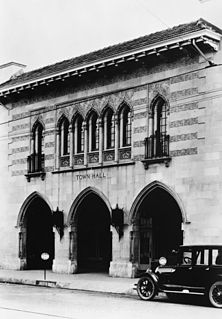
Jules Jacques Benois Benedict was one of the most prominent architects in Colorado history, whose works include a number of well-known landmarks and buildings listed on the National Register of Historic Places.

The Richard H. Mitchell House is a historic residence in Cincinnati, Ohio, United States. Built of stone throughout, this large house was designed by prominent Cincinnati architect Samuel Hannaford. Converted into a school, the house has been named a historic site.
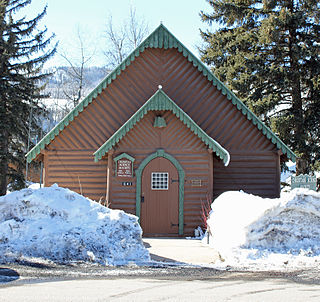
Christian Science Society, also known as Christian Science Society Building, is an historic Christian Science church building located at 641 Oak Street corner of 7th Street in Steamboat Springs, Routt County, Colorado; Built in 1934 of logs on a rubble rock foundation with a shingle roof, it was designed and constructed by local builder Ernest Campbell in the style of architecture that has come to be known as the Rustic style. The society was organized on July 22, 1908, by local Christian Scientists, notable among whom was Margaret Crawford, who with her husband, James Crawford, had founded and named Steamboat Springs in 1875. It met at various local sites until November 4, 1934 when the first service was held in its new building. The building site purchased in 1920 had formerly been occupied by the Onyx Hotel. Christian Science churches and societies are no dedicated until they are free of debt and the Steamboat Springs society was dedicated on December 15, 1935. Regular services have been held ever since. The only significant changes in the building since 1934 have been replacing the roof with a metal one to allow snow to slide off and dropping the interior ceiling for better insulation. The side walls have also been stabilized by running several metal rods between them. On August 22, 2007, the building was added to the National Register of Historic Places.

Frank E. Edbrooke, also known as F.E. Edbrooke, was a 19th and early 20th century architect in Denver, Colorado who has been termed the "dean" of Denver architecture. Several of his surviving works are listed on the National Register of Historic Places including Brinker Collegiate Institute, built in 1880 and NRHP-listed in 1977.

William Ellsworth Fisher was an architect who founded the Denver, Colorado firm that became Fisher & Fisher.

The Baldwin-Wallace College South Campus Historic District is an area of land on the south end of the Baldwin Wallace University campus. When the district was established, the school was Baldwin-Wallace College. BW is a four-year private, coeducation, liberal arts college in Berea, Ohio, United States. The school was founded in 1845 as Baldwin Institute by Methodists settlers. Eventually the school merged with nearby German Wallace College in 1913 to become Baldwin-Wallace College, which adopted the present name in 2012. Several buildings since its founding have been established on the National Register of Historic Places, establishing this area as the Baldwin-Wallace College South Campus Historic District.

James Harvey Crawford (1845-1930) was the founder of Steamboat Springs, Colorado. He was a man of many vocations: soldier, farmer, pioneer, cattleman, miner, land developer, and politician. He was called the "Father of Steamboat Springs", and his wife Margaret Emerine (Bourn) Crawford was called the "Mother of Routt County".

John James Huddart (1856–1930), known usually as John J. Huddart, was a British born and trained architect who practised out of Denver, Colorado in the United States. At the end of the Nineteenth century he was one of Denver's leading architects, known for his work on public buildings and as a courthouse architect. His practice lasted from 1882 to 1930 and commissions included Charles Boettcher House in Denver, Colorado's Fort Morgan State Armory, Denver's Filbeck Building, and six of Colorado's county courthouses.

The Schnull–Rauch House, sometimes referred to as the Victorian Manor and now also branded as The Manor at The Children's Museum of Indianapolis, is a National Register of Historic Places-designated Romanesque Revival historic home constructed in the early 20th century at 3050 North Meridian Street, north of downtown Indianapolis, Indiana.

Hahns Peak Village is an unincorporated community in Routt County, Colorado. It is located north of Clark, Colorado along Routt County Road 129, and just east of Steamboat Lake State Park. The village is named for Hahns Peak, which is nearby.

The Steamboat Springs Depot, at 39265 Routt County Rd. 33B in Steamboat Springs, Colorado, was built in 1909. It was listed on the National Register of Historic Places in 1978.

Columbine or Columbine Gold Camp at 8,697 feet (2,651 m) elevation in Routt County, Colorado near Clark, Colorado is a former community gold mining community, now a populated place and a rental cabin resort. It dates from around 1895. It was listed as a historic district on the National Register of Historic Places in 2007.























